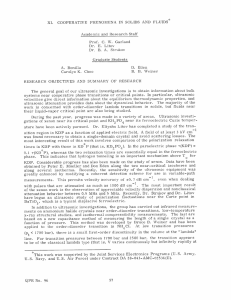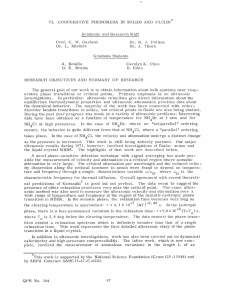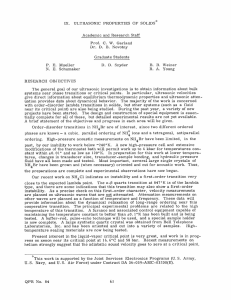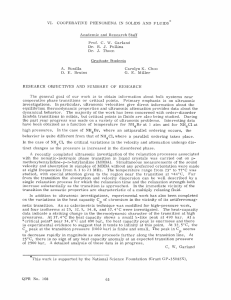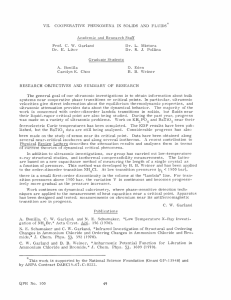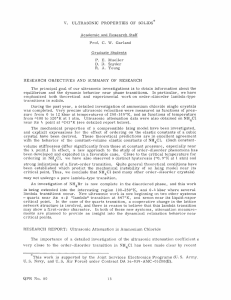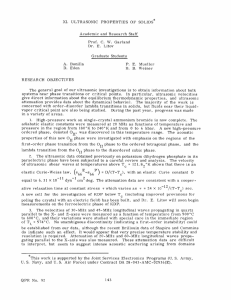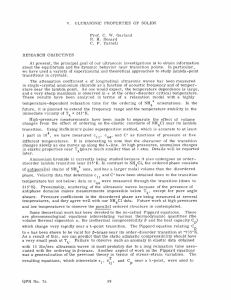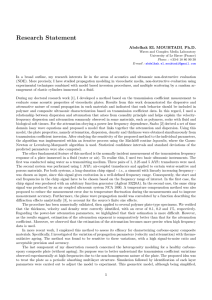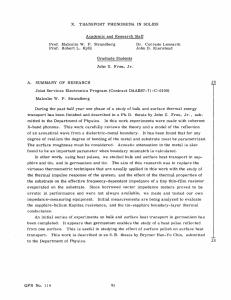ULTRASONIC PROPERTIES OF SOLIDS XI.
advertisement
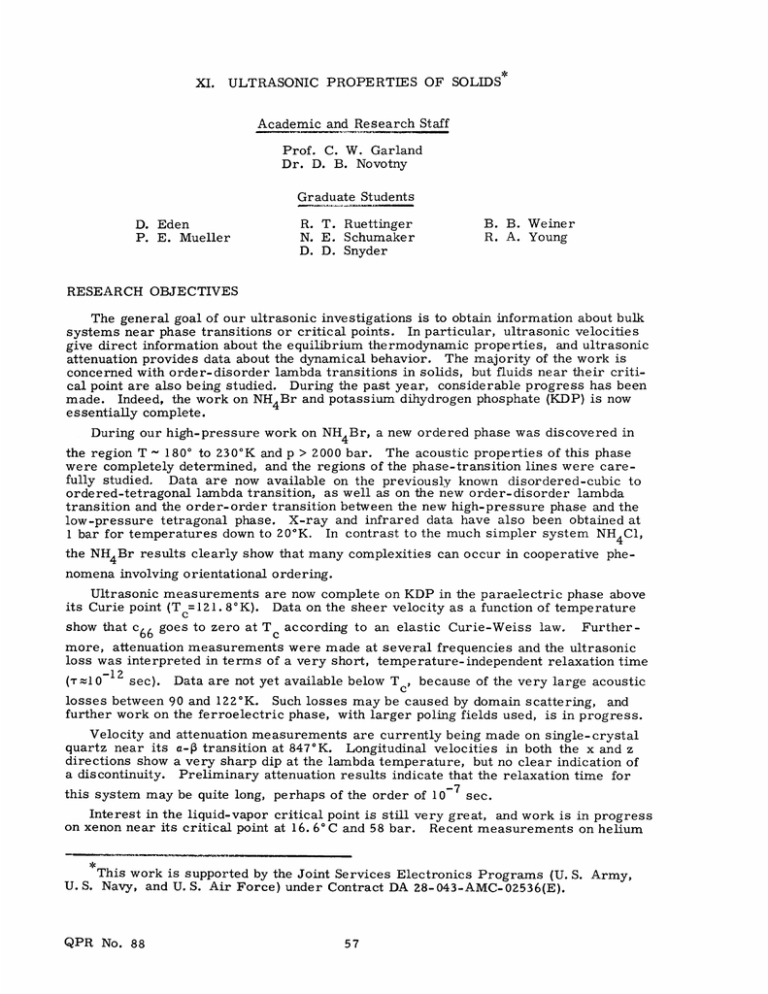
XI. ULTRASONIC PROPERTIES OF SOLIDS Academic and Research Staff Prof. C. W. Garland Dr. D. B. Novotny Graduate Students D. Eden P. E. Mueller R. T. Ruettinger N. E. Schumaker D. D. Snyder B. B. Weiner R. A. Young RESEARCH OBJECTIVES The general goal of our ultrasonic investigations is to obtain information about bulk systems near phase transitions or critical points. In particular, ultrasonic velocities give direct information about the equilibrium thermodynamic properties, and ultrasonic attenuation provides data about the dynamical behavior. The majority of the work is concerned with order-disorder lambda transitions in solids, but fluids near their critical point are also being studied. During the past year, considerable progress has been made. Indeed, the work on NH4Br and potassium dihydrogen phosphate (KDP) is now essentially complete. During our high-pressure work on NH4Br, a new ordered phase was discovered in the region T ~ 1800 to 230'K and p > 2000 bar. The acoustic properties of this phase were completely determined, and the regions of the phase-transition lines were carefully studied. Data are now available on the previously known disordered-cubic to ordered-tetragonal lambda transition, as well as on the new order-disorder lambda transition and the order-order transition between the new high-pressure phase and the low-pressure tetragonal phase. X-ray and infrared data have also been obtained at 1 bar for temperatures down to 20"K. In contrast to the much simpler system NH 4 C1, the NH4Br results clearly show that many complexities can occur in cooperative phenomena involving orientational ordering. Ultrasonic measurements are now complete on KDP in the paraelectric phase above its Curie point (Tc=121. 8K). Data on the sheer velocity as a function of temperature show that c 6 6 goes to zero at T according to an elastic Curie-Weiss law. Further- more, attenuation measurements were made at several frequencies and the ultrasonic loss was interpreted in terms of a very short, temperature-independent relaxation time -12 sec). Data are not yet available below T c , because of the very large acoustic (T10-12 losses between 90 and 122 0 K. Such losses may be caused by domain scattering, and further work on the ferroelectric phase, with larger poling fields used, is in progress. Velocity and attenuation measurements are currently being made on single-crystal quartz near its a-P transition at 847"K. Longitudinal velocities in both the x and z directions show a very sharp dip at the lambda temperature, but no clear indication of a discontinuity. Preliminary attenuation results indicate that the relaxation time for this system may be quite long, perhaps of the order of 10 - 7 sec. Interest in the liquid-vapor critical point is still very great, and work is in progress on xenon near its critical point at 16. 6 0 C and 58 bar. Recent measurements on helium This work is supported by the Joint Services Electronics Programs (U. S. Army, U. S. Navy, and U. S. Air Force) under Contract DA 28-043-AMC-02536(E). QPR No. 88 (XI. ULTRASONIC PROPERTIES OF SOLIDS) suggest that the adiabatic sound velocity may go to zero at a critical point, in contradiction to the classical theoretical view that it will approach a finite minimum. We plan to measure the velocity for AT/Tc values as small as 3 X 10 --66 in order to test this behavior. Accurate acoustic attenuation measurements are also planned over a wide range of frequencies in order to obtain information about the dynamical response of a fluid near its critical point. All equipment for this work has been assembled and tested. Control and measurement of the temperatures and pressure are excellent, and the ultrasonic gear is also working well. Unfortunately, difficulties with the variable-path cell have necessitated the redesign of several features of the cell. These modifications are almost finished, and measurements should begin soon. In order to make direct measurements of the volume of an NH 4 C1 single crystal near its lambda point at high pressures, we have designed and built a special capacitance cell containing two 1-pF capacitors. One capacitor is rigidly mounted and serves to determine the dielectric constant of the gas at each pressure. The other capacitor has a variable gap, since one of its parallel plates is attached to the NH4Cl crystal. When the sample length decreases, the gap will increase by the same amount. Since one can detect capacitance changes of 1 part in 10 5 , this method provides a very sensitive means of studying volume changes. C. W. Garland Public ations a C. W. Garland and R. Renard, "Ultrasonic Investigation of the Order-Disorder Transition in Ammonium Chloride, " Critical Phenomena, Proceedings of a conference held in Washington, D.C., April 1965, NBS Misc. Publ. No. 273, pp. 202-210 (1966). " C. W. Garland and N. E. Schumaker, "Effect of Ordering on the Infrared Spectrum of Ammonium Chloride," J. Phys. Chem. Solids 28, 799 (1967). C. W. Garland and R. A. Young, "Order-Disorder Phenomena VI: Anomalous Changes in the Volume of Ammonium Chloride," J. Chem. Phys. (in press). QPR No. 88
